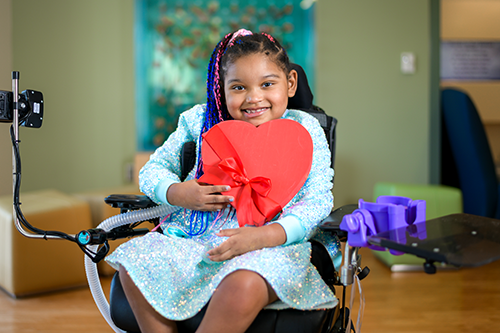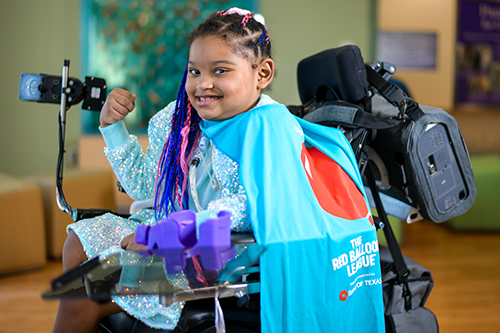
Serenity
When doctors at her local hospital didn’t understand why Serenity couldn’t move her neck or arm, her family found hope and answers for their little ‘firecracker’ at Children’s Health
Six-year-old Serenity loves sparkles, nail polish, unicorns and playing dress-up. She can sometimes convince her two younger brothers to take a break from football talk and play Barbies – and she can always convince her favorite physical therapists, Ashley and Justin, to play princesses.

“I love having a girl. I picked her name before she was born, and it turned out to fit her perfectly. She’s always been naturally calm and peaceful, but every once in a while, she becomes a firecracker and that’s fun to see,” Serentiy's mom, Deanna, said.
Growing up in a small Texas town, Serenity’s life was typical until one day when she complained to her mom, Deanna, that her head hurt. Deanna wasn’t too worried – until a couple of hours later, when Serenity told her mom she couldn’t move her neck or her left arm.
At her local hospital, doctors were puzzled by her symptoms, so Deanna and Serenity flew hundreds of miles to Children’s Health, where physicians began to unpack her symptoms and slow the paralysis on the left side of her body.
“We got to Children’s Health early in the morning, and right away she was in the intensive care unit with maybe 15 people all around her. They could see that she wasn’t able to move, and her face had started to droop a bit like she had a stroke,” Deanna said. “It was overwhelming, but I was also relieved that people were taking her condition seriously.”
An unexpected diagnosis
A few days later, Serenity was diagnosed with acute flaccid myelitis (AFM) likely caused by an infection from an enterovirus – a common virus that usually causes kids to have a fever and a sore throat. But occasionally, the virus triggers an abnormal immune response and overcomes the body’s ability to fight the illness, eventually reaching the nervous system. In the most severe cases, the virus can reach past muscles in the arms and legs and weaken or paralyze the muscles we use to breathe.
“Serenity’s AFM advanced really quickly, so by the time we had a diagnosis, a big portion of her body was paralyzed. Because it got to her lungs, she now uses a ventilator to breathe,” Deanna said. “But the ICU team was really positive. Right away they were figuring out when she could start therapy to prevent muscle loss."
Serenity and her mom stayed in the Children’s Health ICU for six weeks. And when it was time to go home, the team at Children’s Health taught Deanna how to deliver Serenity’s medications through a tube in her stomach and how to use an in-home and mobile ventilator that allowed Serenity to breathe.
The Children’s Health team taught me how to use the machines and how her medications work together. I had to become a medical expert on my child. It’s a lot of work, but her life is worth it. I’m glad everyone is patient with us parents because we are dealing with the emotions of our child being sick and learning to take care of them.
— Deanna, Serenity's mom
Serenity continues to visit Children’s Health twice a month, working with her physical therapists, Justin and Ashley, to strengthen her stomach muscles so that it’s easier to sit upright.
“The nurses, therapists and the child life specialists make her therapy like playtime and make using the equipment a game. That means visits aren’t stressful – more like she’s going to see her friends,” Deanna said. “We love the movie nights and fun stuff that distracts her from feeling like she’s in the hospital.”

She’s also built a strong relationship with her respiratory therapists, who are working on sustaining her lung function.
“They play dress up with me and we dance,” Serenity said.
Although Serenity's progress has been slower than her doctors and Deanna hoped, her progress is steady. High-quality therapy at Children’s Health and regular home health therapy put Serenity in the position to be part of a larger effort to help find new treatments for kids with AFM.
Last year, in coordination with her Children’s Health team, the family went to another hospital, where Serenity became one of the first AFM patients to receive nerve transfer surgery. There, the doctors continued Serenity’s physical and respiratory therapy, and when she was strong enough, they surgically redirected a healthy nerve from one of her ribs and connected it with her partially paralyzed diaphragm.
“The plan is for the surgery to help regenerate the nerves. When her lung collapsed, her diaphragm shifted and now one of her lungs can't open all the way like it should. And so, with the surgery, we hope it starts working and goes back into its normal spot so she can breathe on her own again,” Deanna said.
Day-to-day life is different but still joyful
Now, two years later, their family is used to the ins and outs of caring for Serenity. She's quick in her wheelchair and loves to play outside. Serenity has become more independent, and she and her brothers have adapted games for the three of them to play together.
Deanna knows all too well that many people who see Serenity don't see past her wheelchair and ventilator. But she hopes as Serenity grows up that everyone will instead see her for her bright personality and creativity.
“I know everyone at Children’s Health accepts her, and more than anything, Serenity feels confident here,” Deanna said.
Meet more Children's Health patients
Read more patient stories like Serenity's and meet our Patient Ambassadors to learn how Children's Health makes life better for children.
Support patients like Serenity this holiday season
At Children’s Health, the little red balloon floating next to our name is small but powerful – just like our patients. This red balloon unites the might of academic medicine with the breadth of specialty expertise to offer clinical care without a ceiling. When combined with the power of families and our donors, we are incredible together.
The support of countless people over the years has proven that what we dream of today can become a reality tomorrow. You can help make the impossible possible for the next generation of kids at Children’s Health.
During this special season, help us make some of our patients’ biggest wishes – to play football, to walk again – come true.
Kids count on us. We count on you.
Give to support innovative research, lifesaving treatments and compassionate care.
Did you enjoy this story?
If you would like to receive an email when new stories like this one are posted to our website, please complete the form below. We won't share your information, and you can unsubscribe any time.

